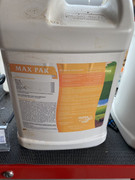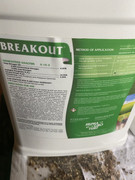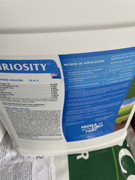Here is why ST6 isn't building products like the Huma Gro products shown into the Interpretation plans we do for members:
Foliar applications of any nutrient need to be done are far-lower application rates -- far, far lower than soil-applied nutrients. This is because the plants (grass) weren't designed by nature to take in nutrients via this method, and if applied directly to the grass at the same rate would be toxic and/or harmful. Yes, foliar applications can and do work -- look at the FAS Iron applications we recommend when the soil is at alkaline pH levels. We do so because there aren't viable alternatives. Also look at the Huma Gro warnings that are on the label and tech sheets referring to the foliar application:
Do not apply this product foliarly in concentrations greater than 10%.
Much like the FAS application that we do, foliar applications don't last that long - the Ferrous Sulfate just shows us how visually - three weeks after applying and mowing, it's gone. The others do the same, but don't supply the same visual cues. Grasses generally do not translocate the nutrients to the roots/soil well - they are designed to translocate nutrients up the plant, and sugars down the plant. Now, if the grass is mowed and mulched, some will wind up in the soil, but why not just apply to the soil in the first place, where that is an option? It's far cheaper and can be applied at much higher levels.
When nutrients are applied at a higher level to the soil, the soil acts as a Bank - building up a reservoir of them faster.
BTW - look at the ingredients on the label of "Max Pak":
Boric Acid, Cobalt Chloride, Sodium Molybdate, Zinc, Manganese, Copper, and Ferrous Sulfates.
We match pretty damned well. They use Boric Acid instead of Borax that we use, but Zinc Sulfate, Copper Sulfate, Manganese Sulfate, and Ferrous Sulfate all match. Cobalt Chloride, Sodium Molybdate (for Molybdenum) are used in such small quantities (look at the label or tech sheet) that they are sometimes that they are considered "nanonutrients" and reliable tests for them are not available at reasonable cost.
I prefer NOT to use pre-mixes of micronutrients because you may not need all of them, and applying some of them when you are at already high levels may cause toxicity (especially Boron).
While you're looking and learning about the label and tech sheet, there's the information about the Sulfur -- in the list of ingredients, the Sulfur is coming from the Copper Sulfate, Manganese Sulfate, Zinc Sulfate and Ferrous Sulfate. All items that we use, but most are at the tablespoons per 1000 sq ft level. This is equivalent to going down to the ocean shore and throwing in a few ounces of salt into the ocean and then asking whether the ocean is now saltier. Technically, yes it is, but you'd never be able to measure the change. The same is true of doing a foliar app of Sulfates and then asking whether the pH will be more acidic in thousands of lbs of Calcium/Magnesium/Potassium in the soil. The change is so small as to be difficult to measure.
And then there's the topper on it all - read the Tech Sheet and see all the fancy wording:
Huma Gro® MAX PAK® is a liquid micronutrient formulation containing a carbon-complexed, highly stable source of many important micronutrients. MAX PAK® is leaf friendly, salt buffered, and formulated with Micro Carbon Technology® to ensure maximum uptake and translocation of nutrients.
8.5% Organic Matter (derived from leonardite)
Ooh, Fancy!!!
There are only two things derived from Leonardite that are useful - Humic Acid and Fulvic Acid. And all that fancy wording never mentions that it's using them. Folks, don't be fooled by "Micro Carbon Technology (MCT)" - it's Humic Acid and Fulvic Acid, and the application rate of one pint per acre of a 8.5% portion of a pint per acre means it ain't going down at any real appreciable level. Ounces per acre. Instead, we have added Humic Acid at 4-5 lbs/yr per 1,000 sq ft of a 70% Humic Acid product, and will be adding Fulvic Acid to the Member plans next year. All the fancy talk in the literature is marketing talk, not product specifics.
These products are really aimed at specific situations (mostly in crops) where a crop is showing a specific problem in an acute way that is caused by a deficiency of a nutrient (mostly micronutrients). An example of a nutrient deficiency is Tomato Blossom Rot, where the issue is not enough Calcium. You use these products to save a crop from disaster, and they work well in that scenario, because crops don't get mowed a couple times a week and the plant doesn't grow out of it (hence the mowing!).
The approach we're taking applies much more of the ingredients/nutrients directly to the soil/bank, uses the Humates at many multiples of the level in these products, and is far cheaper than the "I'll add the water for you" products.
I tried several of these micronutrient solutions with Humates during my four years of Humate product testing (not specifically the Huma Gro product). All of them wound up in either the "ineffective or marginally effective" category or the "too expensive for results achieved" category, when applied to lawns for the effects of Humates.


